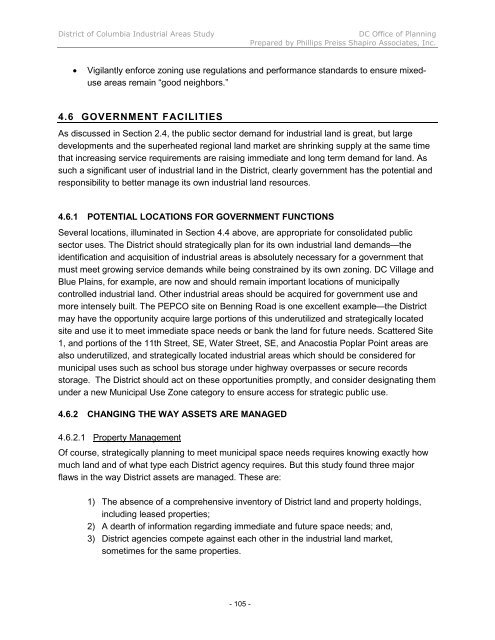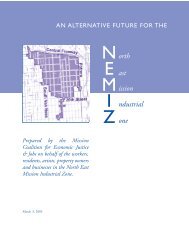INDUSTRIAL LAND IN A POST-INDUSTRIAL CITY District of ...
INDUSTRIAL LAND IN A POST-INDUSTRIAL CITY District of ...
INDUSTRIAL LAND IN A POST-INDUSTRIAL CITY District of ...
Create successful ePaper yourself
Turn your PDF publications into a flip-book with our unique Google optimized e-Paper software.
<strong>District</strong> <strong>of</strong> Columbia Industrial Areas Study DC Office <strong>of</strong> Planning<br />
Prepared by Phillips Preiss Shapiro Associates, Inc.<br />
Vigilantly enforce zoning use regulations and performance standards to ensure mixeduse<br />
areas remain “good neighbors.”<br />
4.6 GOVERNMENT FACILITIES<br />
As discussed in Section 2.4, the public sector demand for industrial land is great, but large<br />
developments and the superheated regional land market are shrinking supply at the same time<br />
that increasing service requirements are raising immediate and long term demand for land. As<br />
such a significant user <strong>of</strong> industrial land in the <strong>District</strong>, clearly government has the potential and<br />
responsibility to better manage its own industrial land resources.<br />
4.6.1 POTENTIAL LOCATIONS FOR GOVERNMENT FUNCTIONS<br />
Several locations, illuminated in Section 4.4 above, are appropriate for consolidated public<br />
sector uses. The <strong>District</strong> should strategically plan for its own industrial land demands—the<br />
identification and acquisition <strong>of</strong> industrial areas is absolutely necessary for a government that<br />
must meet growing service demands while being constrained by its own zoning. DC Village and<br />
Blue Plains, for example, are now and should remain important locations <strong>of</strong> municipally<br />
controlled industrial land. Other industrial areas should be acquired for government use and<br />
more intensely built. The PEPCO site on Benning Road is one excellent example—the <strong>District</strong><br />
may have the opportunity acquire large portions <strong>of</strong> this underutilized and strategically located<br />
site and use it to meet immediate space needs or bank the land for future needs. Scattered Site<br />
1, and portions <strong>of</strong> the 11th Street, SE, Water Street, SE, and Anacostia Poplar Point areas are<br />
also underutilized, and strategically located industrial areas which should be considered for<br />
municipal uses such as school bus storage under highway overpasses or secure records<br />
storage. The <strong>District</strong> should act on these opportunities promptly, and consider designating them<br />
under a new Municipal Use Zone category to ensure access for strategic public use.<br />
4.6.2 CHANG<strong>IN</strong>G THE WAY ASSETS ARE MANAGED<br />
4.6.2.1 Property Management<br />
Of course, strategically planning to meet municipal space needs requires knowing exactly how<br />
much land and <strong>of</strong> what type each <strong>District</strong> agency requires. But this study found three major<br />
flaws in the way <strong>District</strong> assets are managed. These are:<br />
1) The absence <strong>of</strong> a comprehensive inventory <strong>of</strong> <strong>District</strong> land and property holdings,<br />
including leased properties;<br />
2) A dearth <strong>of</strong> information regarding immediate and future space needs; and,<br />
3) <strong>District</strong> agencies compete against each other in the industrial land market,<br />
sometimes for the same properties.<br />
- 105 -












